2018 MERCEDES-BENZ E-CLASS WAGON belt
[x] Cancel search: beltPage 106 of 506

#Toopen: pressrelease cat ch1 and swing
th e co ver of the armrest upwards.
Through-loading feature in there ar ben ch
seat
Fo lding there ar seat backrests forw ard
&
WARNING Risk of injury ifth ere ar
bench seat/rear seat and seat backrest
are not engaged
If th ere ar bench seat/rear seat and seat
backrest are not engaged they could fold for‐
wa rds, e.g. when braking suddenly or in the
ev ent of an accident.
RIfth is is the case, theve hicle occupant
wo uld beforc ed into the seat belt bythe
re ar bench seat/rear seat or bythe seat
backrest. The seat belt cann otprotect as
intended and could result in additional
injur y.
RObjects or loads in the trunk/cargo com‐
partment cannot berestra ined bythe
seat backrest.
#Make sure that the seat backrest and
th ere ar bench seat/rear seat are
engaged before everytrip.
Ifth e seat backrest is not engaged and loc ked,
th is will be shown in the multifunction display in
th e instrument clus ter.
The center and outer seat backrests can be fol‐
ded forw ard separatel y.
The right outer seat backrest can only be folded
fo rw ard toget her with the center seat backrest.
The outer seat backrests are electrically
unloc ked with there lease handles in either the
cargo compart ment or beside the seat backr‐
ests.
#Fu lly inse rtthere ar seat backrest head
re stra ints.
10 4
Seats and stowing
Page 108 of 506

Folding there ar seat backrest back
* NO
TEDama getothe seat belt
The seat belt could become trapped and thus
damaged when folding back the seat back‐
re st.
#Make sure that the seat belt is not trap‐
ped when folding back the seat back‐
re st.
If th e seat backrest is not engaged and loc ked,
th is will be shown in the multifunction display in
th e instrument clus ter.
#Mo vethe driver's or front passenger seat for‐
wa rds, if necessar y.
#Fold cor responding seat backrest 1back
until it engages.
Left and right seat backrests: ifth e seat
backrest is not cor rectly engaged, this will be
shown in the multifunction display in the
instrument clus ter.
Center seat backres t:ifth e seat backrest is
not cor rectly engaged, red lock verification
indicator 2will be visible. Lo
cking the center rear seat backrest
Lock the center seat backrest if youwa ntto
secure the cargo compartment from unauthor‐
ized access. The center seat backrest can then
only be folded forw ard toget her with the left seat
backrest.
Bo th seat backrests must be engaged and joined
to ge ther.
10 6
Seats and stowing
Page 134 of 506
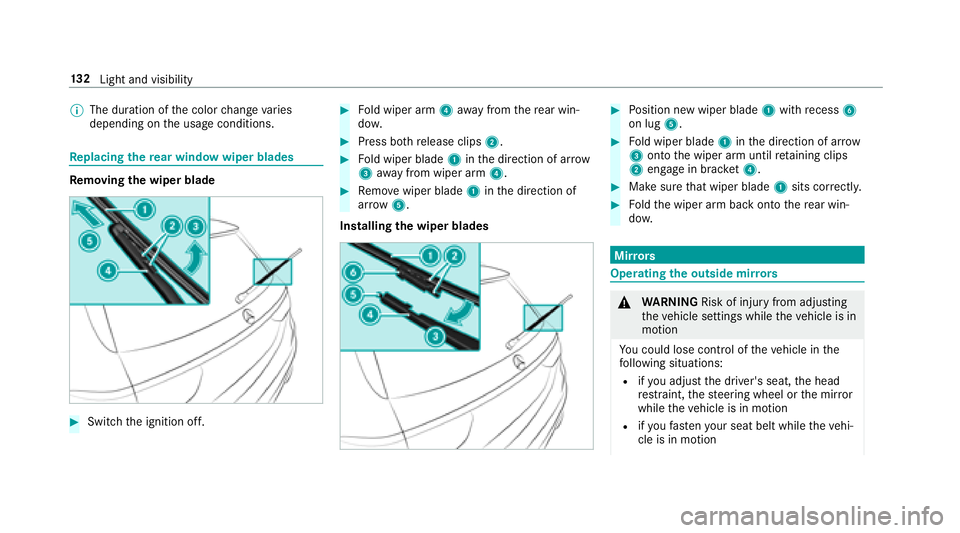
%The duration of the color change varies
depending on the usage conditions.
Re placing the rear window wiper blades
Re moving the wiper blade
#Switch the ignition off.
#Fo ld wiper arm 4away from there ar win‐
do w.
#Press bo threlease clips 2.
#Fold wiper blade 1inthe direction of ar row
3 away from wiper arm 4.
#Remo vewiper blade 1inthe direction of
ar row 5.
Installing the wiper blades
#Po sition new wiper blade 1with recess 6
on lug 5.
#Fold wiper blade 1inthe direction of ar row
3 onto the wiper arm until retaining clips
2 engage in brac ket4.
#Make surethat wiper blade 1sits cor rectl y.
#Foldthe wiper arm back onto there ar win‐
do w.
Mir rors
Operating the outside mir rors
&
WARNING Risk of injury from adjusting
th eve hicle settings while theve hicle is in
motion
Yo u could lose cont rol of theve hicle in the
fo llowing situations:
Rifyo u adjust the driver's seat, the head
re stra int, thesteering wheel or the mir ror
while theve hicle is in motion
Rifyo ufa sten your seat belt while theve hi‐
cle is in motion
13 2
Light and visibility
Page 135 of 506
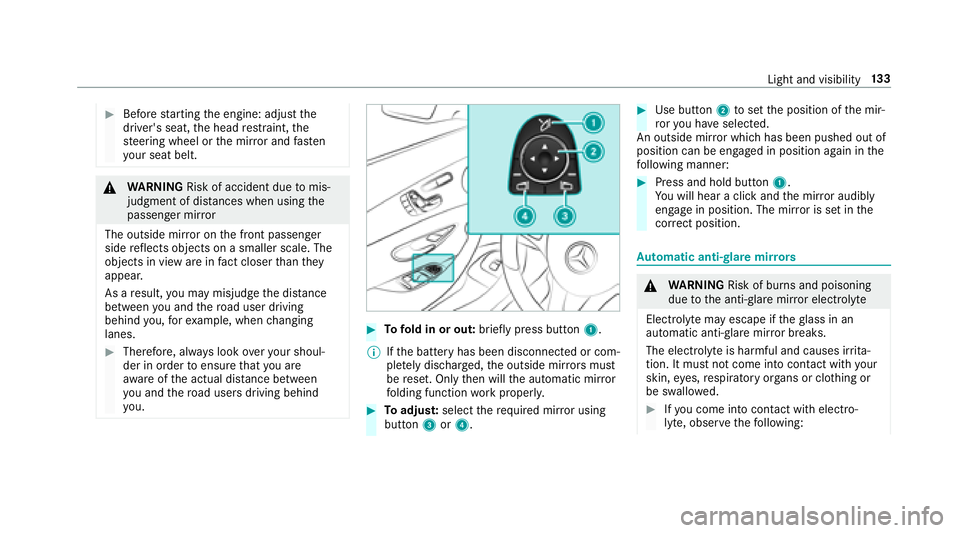
#Beforestarting the engine: adjust the
driver's seat, the head restra int, the
st eering wheel or the mir ror and fasten
yo ur seat belt.
&
WARNING Risk of accident due tomis‐
judgment of dis tances when using the
passenger mir ror
The outside mir ror on the front passenger
side reflects objects on a smaller scale. The
objects in view are in fact closer than they
appear.
As a result, you may misjud gethe dis tance
between you and thero ad user driving
behind you, forex ample, when changing
lanes.
#Therefore, alw ays look over your shoul‐
der inorder toensure that you are
aw are of the actual dis tance between
yo u and thero ad users driving behind
yo u.
#To fold in or out: brieflypress button 1.
% Ifth e battery has been disconnected or com‐
ple tely discharged ,th e outside mir rors must
be reset. Only then will the automatic mir ror
fo lding function workproperly.
#To adjus t:select therequ ired mir ror using
button 3or4.
#Use button 2toset the position of the mir‐
ro ryo u ha veselected.
An outside mir ror which has been pushed out of
position can be engaged in position again in the
fo llowing manner:
#Press and hold button 1.
Yo u will hear a click and the mir ror audibly
engage in position. The mir ror is set in the
cor rect position.
Au tomatic anti-glare mir rors
&
WARNING Risk of burn s and poisoning
due tothe anti- glare mir ror electrolyte
Electrolyte may escape if theglass in an
automatic anti-glare mir ror breaks.
The electrolyte is harmful and causes ir rita ‐
tion. It must not come into contact wi thyour
skin, eyes,respiratory organs or clo thing or
be swallo wed.
#Ifyo u come into contact with electro‐
ly te , obser vethefo llowing:
Light and visibility 13
3
Page 165 of 506
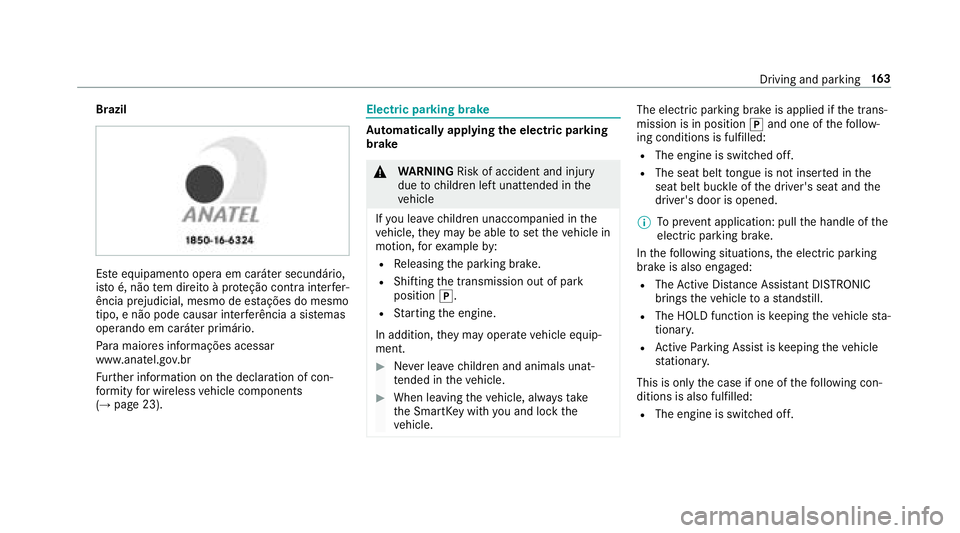
Brazil
Este equipamento opera em caráter secundário,
is to é, não tem direito à pr oteção contra inter fer‐
ência prejudicial, mesmo de es tações do mesmo
tipo, e não pode causar inter ferê ncia a sist emas
operando em caráter primário.
Pa ra maio res informações acessar
www.anatel.go v.br
Fu rther information on the declaration of con‐
fo rm ity for wireless vehicle components
(
→page 23).
Electric parking brake
Au tomatically applying the electric parking
brake
& WARNING Risk of accident and injury
due tochildren left unatte nded inthe
ve hicle
If yo u lea vechildren unaccompanied in the
ve hicle, they may be able toset theve hicle in
motion, forex ample by:
RRe leasing the parking brake.
RShifting the transmission out of park
position j.
RStarting the engine.
In addition, they may operate vehicle equip‐
ment.
#Ne ver lea vechildren and animals unat‐
te nded in theve hicle.
#When leaving theve hicle, alw aysta ke
th e SmartK eywith you and lock the
ve hicle.
The electric parking brake is applied if the trans‐
mission is in position jand one of thefo llow‐
ing conditions is fulfilled:
RThe engine is switched off.
RThe seat belt tongue is not inser ted in the
seat belt buckle of the driver's seat and the
driver's door is opened.
% Toprev ent application: pull the handle of the
electric parking brake.
In thefo llowing situations, the electric parking
brake is also engaged:
RThe Active Dis tance Assist ant DISTRO NIC
brings theve hicle toast andstill.
RThe HOLD function is keeping theve hicle sta‐
tionar y.
RActive Parking Assist is keeping theve hicle
st ationar y.
This is only the case if one of thefo llowing con‐
ditions is also fulfilled:
RThe engine is switched off.
Driving and parking 16
3
Page 166 of 506
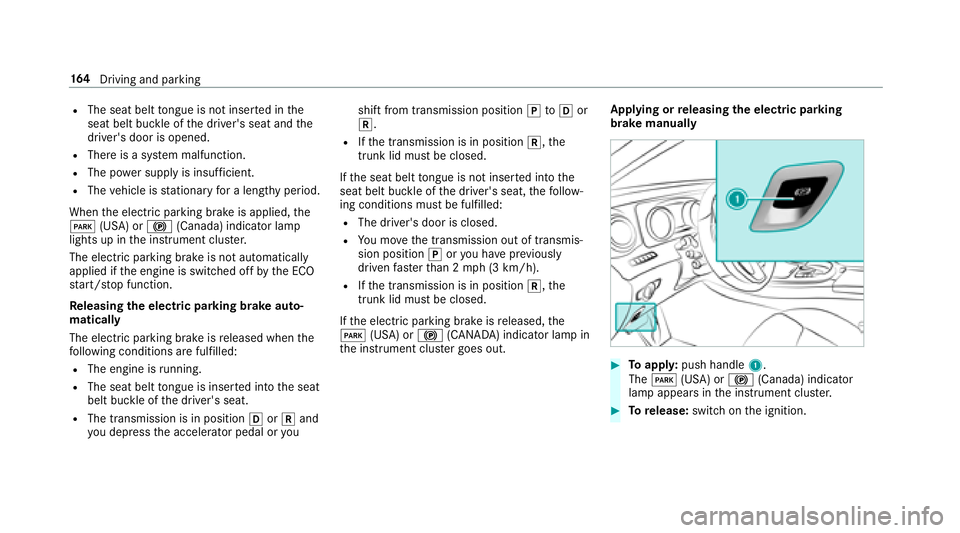
RThe seat belttongue is not inser ted in the
seat belt buckle of the driver's seat and the
driver's door is opened.
RThere is a sy stem malfunction.
RThe po wer supp lyis insuf ficient.
RThe vehicle is stationary for a lengt hyperiod.
When the electric parking brake is applied, the
F (USA) or !(Canada) indicator lamp
lights up in the instrument clus ter.
The electric parking brake is not automatically
applied if the engine is switched off bythe ECO
st art/ stop function.
Re leasing the electric pa rking brake auto‐
matically
The elect ric park ing brake is released when the
fo llowing conditions are fulfilled:
RThe engine is running.
RThe seat belt tongue is inser ted into the seat
belt buckle of the driver's seat.
RThe transmission is in position hork and
yo udepr essthe accelera tor pedal or you shift from transmission position
jtoh or
k.
RIf th e transmission is in position k,the
trunk lid must be closed.
If th e seat belt tongue is not inser ted into the
seat belt buckle of the driver's seat, thefo llow‐
ing conditions must be fulfilled:
RThe driver's door is closed.
RYo u mo vethe transmission out of transmis‐
sion position joryou ha veprev iously
driven fasterthan 2 mph (3 km/h).
RIfth e transmission is in position k,the
trunk lid must be closed.
If th e elect
ric parking brake is released, the
F (USA) or !(CANADA) indicator lamp in
th e instrument clus ter goes out. Applying or
releasing the electric pa rking
brake manually
#To appl y:push handle 1.
The F (USA) or !(Canada) indicator
lamp appears in the instrument clus ter.
#To release: switch on the ignition.
16 4
Driving and pa rking
Page 188 of 506

pedal. Never attem pttolea vetheve hi‐
cle if it is being held byHill Start Assist.
HOLD function
HOLD function
The HOLD function holds theve hicle at a stand‐
st ill without requ iring youto depress the brake
pedal, e.g. when pulling away on steep slopes.
Sy stem limitations
The incline must not be greaterth an 30%.
Ac tivating/deactivating the HOLD function
&
WARNING Risk of an accident due tothe
HOLD function being activated when you
lea vetheve hicle
If yo u lea vetheve hicle while only the HOLD
function is braking theve hicle, theve hicle
can rollaw ay inthefo llowing situations:
RIf th ere is a malfunction in the sy stem or
in the po wer supp ly.
RIf th e HOLD function is deactivated by
depressing the accelera tor pedal or the
brake pedal, e.g. byave hicle occupant.
RIfth e electrics in the engine compart‐
ment, the battery or the fuses are tam‐
pered with or if the battery is disconnec‐
te d.
#Alw ays deactivate the HOLD function
and secure theve hicle against rolling
aw ay before leaving theve hicle.
* NO
TEDama gefrom au tomatic braking
When Active Brake Assi st,Ac tive Dis tance
Assist DISTRONIC or the HOLD function are
activated, theve hicle brakes autonomously
in cer tain situations.
To avo id damage totheve hicle, deactivate
th ese sy stems in thefo llowing or similar sit‐
uations:
#During towing
#In a car wash
Requirements:RThe vehicle is stationar y.
RThe driver's door is closed or the seat belt on
th e driver's side is fastened.
RThe engine is running or has been au tomati‐
cally switched off bythe ECO start/ stop
function.
RThe electric parking brake is released.
RAc tive Dis tance Assist DISTRONIC is not acti‐
va ted.
RThe transmission is in position h,kori.
Ac tivating the HOLD function
#Dep ress the brake pedal and af ter a short
time depress fur ther until theë display
appears in the multifunction displa y.
#Release the brake pedal.
Deactivating the HOLD function
#Depress the accelerator pedal topull away.
or
#Depress the brake pedal until theë dis‐
play disappears from the multifunction dis‐
pla y.
186
Driving and pa rking
Page 189 of 506
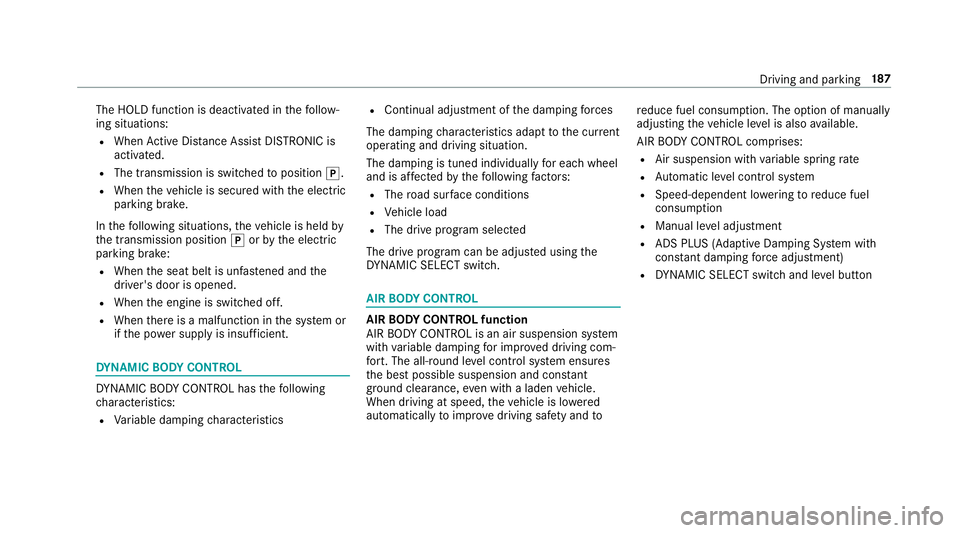
The HOLD function is deactivated inthefo llow‐
ing situations:
RWhen Active Dis tance Assist DISTRONIC is
acti vated.
RThe transmission is switched toposition j.
RWhentheve hicle is secured with the electric
parking brake.
In thefo llowing situations, theve hicle is held by
th e transmission position jorby the electric
parking brake:
RWhen the seat belt is unfas tened and the
driver's door is opened.
RWhen the engine is switched off.
RWhen there is a malfunction in the sy stem or
if th e po wer supply is insufficient.
DY NA MIC BODY CONT ROL
DYNA MIC BODY CONTROL has thefo llowing
ch aracteristics:
RVa riable damping characteristics
RContinual adjustment of the damping forc es
The damping characteristics adapt tothe cur rent
operating and driving situation.
The da mping is tuned individually for each wheel
and is af fected bythefo llowing factors:
RThe road sur face conditions
RVe hicle load
RThe drive program selected
The drive program can be adjus ted using the
DY NA MIC SELECT switch.
AIR BODY CONT ROL
AIR BODY CONT ROL function
AIR BODY CONTROL is an air suspension sy stem
with variable damping for impr oved driving com‐
fo rt. The all-round le vel control sy stem ensures
th e best possible suspension and const ant
ground clearance, even with a laden vehicle.
When driving at speed, theve hicle is lo wered
automatically toimpr ovedriving saf etyand to re
duce fuel consum ption. The option of manually
adjusting theve hicle le vel is also available.
AIR BODY CONTROL comprises:
RAir suspension with variable spring rate
RAu tomatic le vel control sy stem
RSpeed-dependent lo wering toreduce fuel
consum ption
RManual le vel adjustment
RADS PLUS (Adaptive Damping Sy stem with
const ant damping forc e adjustment)
RDY NA MIC SELECT switch and le vel button
Driving and parking 18
7